Abstract
In the evolving economic landscape, Industry 4.0 emphasizes strategic planning and operational progress for large enterprises. This transformation relies on smart robotization technologies like AGVs (Automated Guided Vehicles) and AMRs (Autonomous Mobile Robots) for reducing transportation time, thereby reducing energy costs per unit of production, increasing energy efficiency, as well as replacing combustible-fuel-powered tools with electric ones. A number of concerns arise with their introduction into the production cycle. This research aims to provide a methodical basis for averting substantial mistakes when executing projects centered around the incorporation of AGVs/AMRs into in-house logistics systems. The FMEA method and empirical analysis were employed to achieve a more accurate risk assessment. APIS and MS Excel softwares were chosen. We investigated the potential hazards related to the incorporation of mobile robotic solutions and identified both external and internal threats. To streamline and improve project efficiency, a risk management algorithm for high-tech projects is presented in the paper. Integrating FMEA into projects implementing robotic technologies can lead to significant enhancements in risk reduction, and therefore cost savings, efficiency, safety, and quality, while fostering a culture of collaboration and problem solving. The research contributes to the literature by introducing an AMR planning and control framework to guide managers in the decision-making process, thereby supporting them to achieve optimal performance. Finally, we propose an agenda for future research within the field of interest.
1. Introduction
The European Bank for Reconstruction and Development’s technical guidance on transitioning to a green economy highlights the importance of modernizing energy supply (EBRD 2022). Key methods include installing efficient equipment, optimizing production technology, reducing heat losses, increasing waste heat recovery, and using advanced automation technologies. Many companies now prioritize this approach, with mobile robotic applications like AGVs and AMRs accounting for over 40% (Wiferion 2022) of automation within enterprises. As Robert Bogue stated, robotics finds applications in renewable energy, recycling, waste management (Bogue 2022), and sustainable transport (Guilherme et al. 2019). Moreover, minimizing acceleration in industrial robotic systems can reduce energy consumption by up to 30%, as shown by a study from Chalmers University of Technology.
1.1. Automated Material Handling
At present, AGV/AMR technology may no longer be surprising, yet there continues to be a significant number of enterprises in the early stages of implementing these technologies within their production systems, particularly in transitioning economies. An AGV (Automated Guided Vehicle) is a mobile robot capable of handling materials according to a preprogrammed route. A few standard types of these devices can be seen in Appendix A. There is a wide variety of navigation technologies available: magnetic guidance, line tracking, lidar, GPS guidance, etc. Precise manipulation during the collection/loading of cargo typically occurs using RFID (Radio Frequency Identification) tags. It is important to note that unlike AMR technology, AGVs do not deviate from their designated transportation path and cannot autonomously plan routes.
AMR (Autonomous Mobile Robot) and AGV (Automated Guided Vehicle) technologies may look and function similarly, but AMRs have added capabilities. Key features include smart navigation, based on easily uploaded and updated maps; obstacle detection using sensors and machine vision that alert personnel through SMS or SAP; and emergency rerouting that avoids forbidden zones and reduces supply chain disruptions. AMRs are also highly adaptable, able to quickly provide recon for various tasks, making them useful for complex logistics operations.
Vitalii et al. (2021) developed a model for minimizing energy consumption of AGV and AMR technologies with reference to the International Standard VDI 2198. Their proposed model demonstrated a significant reduction in energy consumption for internal transportation. Robotic vehicles can also contribute to a company’s energy efficiency and greenhouse gas emission reduction strategies through the following means:
- Enhancing the efficiency of electric motors and batteries, as well as introducing energy recovery systems during braking or decreasing the load while transporting goods, the overall energy consumption can be reduced.
- Employing modern, long-cycle lithium batteries, which research has shown to significantly improve overall greenhouse gas emissions throughout their lifecycle.
However, AMRs have their drawbacks, and at the moment the upmost issue is the expensiveness of such a solution. The second, but no less important, issue is a shortage of suppliers. This influences decision making in a tender process and imposes certain restrictions on the technical characteristics of devices.
1.2. Literature Review
The literature on AGV/AMR technologies mostly focuses on technical issues and is aimed at researching the technology itself, rather than integrating it in the business process. The vast majority of research works could be divided into three focus areas: technical optimization of devices, planning of device activity, and modeling of systems according to specified parameters. Among the works on technical optimization issues, the most common are studies on optimizing battery charging (Xiangnan et al. 2019) and on improving the energy efficiency of AGVs/AMRs, both in terms of mathematical calculations (Nitish et al. 2022) and in terms of analyzing the results of system integration as a whole (Johannes et al. 2015; Francisco et al. 2021; Bohacs et al. 2021). Some articles are devoted to the study of the navigation of equipment itself (Abdurrahman and Hakan 2019; Martijn et al. 2019), or its controlling sensors (Jittima and Toshio 2016; Ludger et al. 2016; Weiyang et al. 2018). Some researchers (Quang-Vinh et al. 2021; De Ryck et al. 2021, 2022) study the implementation of AGV/AMR technology, taking into account the optimal distribution of orders and limited resources. Among the works that study the technique of modeling the devices’ activity, we can distinguish two main paths: simulations of the AGV/AMR devices’ implementation in various enterprises (Hana and Gabriel 2017; Ning et al. 2021), and simulations of technology implementation in conjunction with supporting tools (Jittima and Toshio 2016) or innovation strategies (Saadettin and Ömer 2007). To summarize, research on AGV/AMR technology focuses primarily on the integrator’s perspective rather than that of the consumers. While this enables better solutions from manufacturers, it limits consumers’ ability to reduce extra costs associated with integrating existing systems. Additionally, the current literature lacks studies identifying barriers to implementing automated technologies in production systems.
In Russia, there is currently only one research paper publicly available (Stoychich et al. 2019) that discusses using FUCOM and EDAS methodologies, along with correction methods like WASPAS, SAW, MABAC, and ARAS, to help select an appropriate AGV model for automating industrial processes. The situation is different in developed countries, where more research is available due to the wider adoption of AGV technologies. Notable studies include Vitalii et al. (2021), which found that replacing human-controlled vehicles with autonomous mobile robots could significantly reduce energy consumption, even without modifying the control system. Ozan et al. (2021) explored reducing peak loads and lowering energy costs for companies implementing AGVs in their production processes. Additionally, several other relevant studies on the subject include Guilherme et al. (2019), which focused on the sustainable implementation of AGVs in the Brazilian industry; Puneeth et al. (2018), which examined the size of AGV fleets and their impact on operations; and Hee-Woon and Hwally (2018), which looked at the efficiency of AGVs for small businesses. Despite the growing body of research, there is a distinct lack of articles addressing the risks and obstacles associated with integrating AGVs into production cycles.
This study aims to offer a methodological foundation for the prevention of significant errors in implementing projects focused on AGV/AMR integration into an internal supply system.
2. Materials and Methods
This research is based on the analysis of risks associated with entry barriers for the implementation of AGV/AMR technology in the supply chain. The empirical basis is the data obtained from surveys, conducted by the authors, of the experts and companies’ representatives, i.e., BSH Bytowije Pribory LLC, Robotechnika LLC, SAFELOG GmbH, Omron Electronics LLC, InduTech LLC, Robovizard LLC, Jungheinrich lifting Loading Equipment, and LLC Energy (NRG Corporation., Ltd., Worthing, England), as well as interviews conducted with some of them (for an example of a completed survey, please see Appendix C, Appendix D, Appendix E).
We have applied the FMEA method and conducted analysis on the basis of the APIS software. The theoretical background of the Failure Modes and Effects Analysis (FMEA) implementation in project management can be traced to its origins in the fields of risk management, reliability engineering, and quality management. FMEA is a systematic, proactive method for identifying and prioritizing potential failure modes in a system, followed by assessing the consequences of these failures and determining appropriate mitigation measures to minimize risks:
- Risk management: FMEA plays a critical role in risk management, as it helps identify and rank risks based on their severity, probability, and detection. The approach allows project managers to focus their efforts on addressing high-priority risks, thereby minimizing potential negative impacts on project milestones, budgets, and objectives (Stamatis 2003).
- Reliability engineering: The origins of FMEA are in the reliability engineering, where it emerged as a method to assess potential failure points in systems (particularly in the aerospace, military, and nuclear industries) to ensure dependable performance and safety. In the context of project management, the implementation of FMEA contributes to the design of more robust, reliable, and safe solutions, reducing the chances of project delays or failures (Latino and Latino 2006).
- Quality management: FMEA is also commonly used in various quality management systems, such as Six Sigma, Lean Manufacturing, and the ISO 9001 quality management standard (https://www.iso.org/iso-9001-quality-management.html, accessed on 9 September 2023). In these contexts, it serves as a tool to identify potential sources of errors or defects and to develop appropriate preventive actions. By integrating FMEA into project management processes, project managers can enhance overall project quality and stakeholder satisfaction by proactively addressing possible failure points (Naslund and Williamson 2010).
This tool allows one to eliminate errors both at an early stage of product development and during production processes by identifying potential failures with high criticality. To conduct this analysis, the method of constructing a graphical model of a standard enterprise supply system in the form of a “flow diagram” was used. Utilizing such a model, it is possible to visually examine the system of internal movement of materials, as well as to take into account the greatest number of risks associated with the supply cycle. MS Excel software was used to prepare the flowchart to identify the main entry barriers for the enterprise when applying AGV/AMR technology from different sides of the project.
3. Results
Today, AGV/AMR technologies are used in almost all areas of industry and production, from consumer electronics to steel and shipbuilding plants. One example, kindly shown to us by Jungheinrich, is the implementation of AGVs in dairy production in the Krasnodar Territory (more detailed information can be found in Appendix B). Today, Automated Guided Vehicle (AGV) and Autonomous Mobile Robot (AMR) technologies have become widely utilized across numerous industries and production fields, ranging from consumer electronics to steel and shipbuilding plants. One notable example, provided by Jungheinrich, highlights the implementation of AGV in a dairy production facility in the Krasnodar Territory.
Background: The dairy production facility in the Krasnodar Territory is a large-scale enterprise focused on processing milk and manufacturing dairy products. The facility sought to automate its material-handling processes to increase operational efficiency while maintaining stringent hygiene standards.
Objective: To improve efficiency, productivity, and hygiene within the dairy production facility by implementing AGV/AMR technologies for material handling, transportation, and warehousing.
Solution: The facility integrated Jungheinrich AGV systems, automating internal transportation of raw materials, additives, packaging, and finished goods. These AGV/AMR systems were designed to accommodate the specific requirements of the dairy industry, such as maintaining cleanliness, providing smooth navigation, and ensuring the careful handling of delicate products. The AGV systems replaced manual labor, with the benefits of reduced operational costs, increased accuracy, and improved safety.
Key Components of the AGV/AMR Implementation:
- Customized AGV: The AGVs used in the facility were tailored to suit the size, weight, and type of goods being transported. The vehicles also featured washdown-compatible bodies designed to withstand rigorous cleaning processes required in the dairy industry.
- Navigation System: The AGV system included a precise navigation system that allowed for identifying optimal routes, avoiding obstacles, and maintaining a safe distance from other AGVs and employees.
- Software Integration: AGV software was integrated into the dairy production facility’s existing warehouse management system, ensuring seamless communication and coordination between multiple processes and operations.
Outcome: The implementation of AGV/AMR technologies in the Krasnodar Territory dairy production facility led to substantial improvements in efficiency, productivity, and hygiene. The automated systems enabled the facility to optimize material-handling tasks, reduce labor costs, maintain a high level of cleanliness, and minimize product damage. This successful integration of AGV/AMR technologies demonstrated the potential benefits of automation for other dairy and food production industries.
However, many companies are at the initial stage of implementation, which raises the question of information and methodological support, since at the moment there are very few publicly available articles on this topic. The risks associated with the implementation of AGV/AMR technology in an enterprise are considered in this paper from three major perspectives (Figure 1):
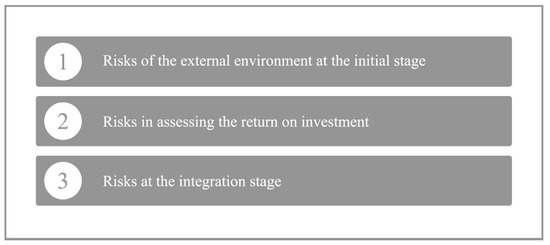
Figure 1.
The risks associated with the implementation of AGV/AMR technology in an enterprise.
In this section, we address each risk individually; whereas in the subsequent section, we will compile the findings to obtain a comprehensive understanding of the overall situation.
- (1)
- Risks of the external environment at the initial stage.
Any informatization and automation project, or rather, its deadlines, cost projection, and quality of implementation, are significantly influenced by external factors, that is, those that are more related to the service provider than to the customer himself. Based on our company surveys, experts collaborations, as well as information collected from publicly available sources, we can list the main risks of the external environment that arise during the implementation of the robotization process:
- Disruptions in the supply of AGV/AMR components due to a shortage. This problem is especially acute now, and specifically with a shortage in the semiconductor markets, which are an integral part of the electronics of mobile robots. The shortage can significantly prolong the project, but also make it irrational or even dangerous on the part of the customer’s management. In addition, there is a risk of “hiding” the shortage problem from the supplier side, the purpose of which may be to obtain a contract at any cost.
- Pandemics or any other acute crises that have a strong impact on the logistics of the components. The consequences of this risk are the same as those in the previous one, with one exception: in this case, the movement of a highly qualified workforce for the installation and debugging phase in the field of robotics also stops. This problem particularly affects the Russian market, where the AGV/AMR sector is under development.
- Increases in customs duties and taxes. Due to the globalization of production chains, many components are usually manufactured and assembled in different countries, and the cost of semifinished products in the final assembly can be greatly increased. This is especially true for the transitive markets: the production of most components and robotic devices abroad causes a number of additional costs, and due to the relatively low wages in the emerging markets, when assessing the return on investment (ROI), even a slight increase in the cost of a project can lead to a failure on its implementation.
- The compulsion of robotics suppliers, because of market fragmentation, to provide standardized solutions with no local differentiation across diverse markets due to varying regulations. SMEs face challenges as large international corporations with vast financial and intellectual resources adopt AGV/AMR technologies worldwide. This not only shrinks the local market supply, potentially leaving businesses without optimal providers, but also creates barriers for smaller organizations in those countries. These companies become less appealing to AGV/AMR integrators due to their low order volume. Though more prevalent in Europe, this issue is also relevant for transitional markets, especially in countries with extensive territories and uneven economic development.
- The creation of new ESG challenges due to global energy transitions. Companies are assessed on short-, medium-, and long-term goals for reducing greenhouse gas emissions across Scopes 1, 2, and 3, using renewable energy sources and improving energy efficiency in production processes. These additional evaluation criteria can be expensive for companies. With the energy agenda increasingly driving investment decisions, Russia-based companies in initial stages of compliance face obstacles to implementing automation and robotization projects.
- Lack of legal support due to the lack of regulations related to health and safety and the use of autonomous robots. Due to the relative short period of the Russian robotization market existence, regulatory basis is still at the development stage. As part of this, the Ministry of Economic Development of the Russian Federation issued the “Concept for the development of regulation of relations in the field of AI and robotics technologies until 2024” (Decree of the Government of the Russian Federation 2020), which became the first document in the RF that forms the basis for regulation of AI and robotics technologies (Xiangnan et al. 2019).
- Miscalculations in energy consumption, which can occur when companies adopt navigation technologies to reduce labor costs by expanding their robotics fleet, leading to decreased energy efficiency during turbulent times. However, optimizing material handling with AGV/AMR devices typically increases production per unit of time, reducing the need for other electrical appliances in the production chain and thereby decreasing overall electricity consumption. This highlights the goal of improving energy efficiency through the implementation of AGVs/AMRs, which is often overlooked in calculations that only account for the devices and their energy consumption.
- (2)
- Risks in assessing the return on investment.
As with any other project, the implementation of robotic technology into an enterprise is usually quite profitable. Based on the collected information, there are three main types of benefits from the introduction of automatic navigation technologies, namely:
- Financial. Any company replacing the physical labor of a person with robotic equipment wins on the labor rate of the employee, as well as on all other payments associated with this employee (i.e., social security, health and safety, etc. (Pisarenko 2014).
- Safety. Enhancing safety culture through AGV/AMR technology in warehousing offers a more secure alternative to human-operated systems. As large companies prioritize industrial robotics adoption, the safety benefits can offset financial losses from such projects.
- Reputational. Industry 4.0 projects in transitional economies garner significant media attention, shaping positive public perception. These initiatives allow companies to showcase their competitive edge, both against external competitors and within their corporation, even among different departments. Moreover, automation projects involving AGV/AMR technology can reduce carbon emissions, as they replace traditional gasoline or diesel-fueled vehicles. This alignment with the green economy further enhances a company’s image and reputation.
There are also several risks associated with the introduction of automatic navigation technologies, namely:
- Risks in inaccurate ROI estimation. While assessing a project’s ROI, management takes into account financial, safety, and reputational benefits. However, gauging risks for financial prospects is not always clear-cut. Automated navigation technologies may reduce employee count, and in countries with low labor costs, implementing these technologies might face challenges.
- Risk of errors in staff workload calculations. When assessing return on investment (ROI) or other methods, companies typically focus on direct financial benefits from projects, such as a worker’s salary, equipment maintenance costs, and energy consumption. However, robotic integration does not always result in employee layoffs; often, employees are reassigned to different tasks. Consequently, a worker’s workload may decrease, e.g., from 87% to 65%, with the remaining 22% allocated to other tasks or unaccounted overtime. These factors are often overlooked in conventional computation methods, leading to potential inaccuracies.
- Risks of equipment damage due to industrial safety violations/low qualification of personnel. This is when the client and the customer cannot come to a common agreement on the responsibility of the parties in situations involving damage to the equipment, infrastructure of the enterprise, or injury to employees of the company when using AGV/AMR robotic equipment. In the event of such a conflict, both parties should refer to the existing regulations and rules in the legislation of the country in which the customer enterprise is located. However, in cases where the legislative framework of the state does not state clear boundaries for the allocation of liability on this issue, or it is insufficiently elaborated, a situation arises when both sides of the project will not be able to come to a common agreement.
- Reputation risks. From the side of obtaining reputation benefits, there may be a reverse effect if the project goes into operation, but will not be implemented at the enterprise for one reason or another, unrelated to insurmountable circumstances. This applies not only to the CEO of the company and their responsibility to shareholders, but also to line managers as well as employees of those departments within which an attempt was made to implement the project.
- (3)
- Risks at the integration stage
Now, let us discuss the most challenging part of AGV/AMR project implementation: integrating it into the production system. Based on field research and in-depth interviews, this group of risks is considered the most significant, impacting both the payback period and overall automation effectiveness. Integration risks may occur due to poor production preparedness. Since the production process is a cohesive system, any failure or shutdown can cause disruptions, spoilage, injuries, or supply issues—a major concern for management.
Additionally, many companies find that introducing AGV/AMR automation technologies requires extra expenses, sometimes including major renovations like floor reconstruction or facility rearrangement. These factors not only affect the cost, but also create numerous challenges and consequences for the company.
There is one more obstacle: the lack of standards for the software of automatic AGV/AMR robots and their integration with WMS and ERP systems (more inherent in the transitive markets), which pushes companies to integrate such equipment in a situation where, each time, the issue of software must be solved anew.
In addition to the topics discussed earlier, several challenges arise when integrating automated equipment into warehouse and production systems:
- Ensuring uniformity and compatibility: Automated carriers rely on precise navigation and require uniform loading equipment and materials. Suppliers’ packaging may vary, making it difficult to achieve uniformity. Transferring materials to AGV/AMR-compatible materials can be time-consuming and challenging.
- Preparing pick-up locations: Companies must assess the sufficiency of floor space for AGV/AMR devices when integrating them into high-altitude storage systems. Coordination between human labor and AGV/AMR technology is crucial for a seamless transition.
- Addressing delivery path issues: Proper infrastructure, including flooring, elevators, and ramps, is necessary for the implementation of AGVs/AMRs. In some cases, adjustments might need to be made to accommodate the technology, such as widening passages.
- Managing challenges in the receipts-holding area: Sufficient floor space in operational areas must be ensured for automated equipment. To manage the buffering of materials, companies must account for variable factors such as the manual lifting of tables and empty containers. Developing an algorithm within the AGV/AMR program to navigate these constraints is essential for successful integration.
FMEA
In this section, we present a deeper analysis of the risks of integrating the AGV/AMR system into the production cycle. Due to the complexity and versatility of this process, we have built an FMEA, which is currently used by many enterprises to study risks in their processes. This tool allows one not only to identify the hazards of the entire operational cycle, but also makes it possible to automatically duplicate similar risks without losing them during the analysis process. In order to identify as many risks as possible during the supply stage of a production area or a preproduction zone, three steps must be performed:
- Draw up a visual flowchart describing the supply process itself. This is necessary in order to step-by-step identify the participants (addressees) of the risk, as well as to consider all kinds of situations in which these dangers are possible;
- Enter all the information into the APIS “IQ-Tools” program so that it is possible to build a block diagram of the links between the risk, its cause, and its consequences;
- Download the program report, where it will be possible to rate each risk and review the main trends.
The first step is to study the standard scheme of supply in the enterprise. For this, the method of graphical modeling of processes was used according to the principle of block diagram (Figure 2).
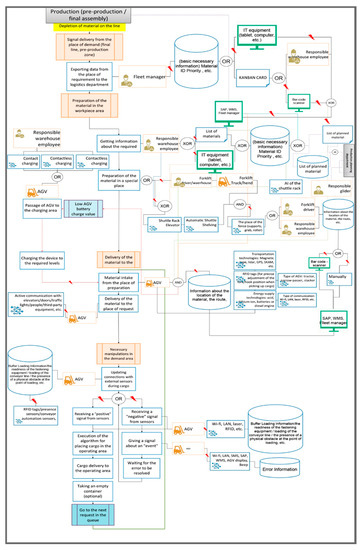
Figure 2.
Flowchart illustrating the standard process of supplying materials to a production line within an organization. Compiled by the authors.
During the development of this model, the process was divided into four main stages:
- Signaling a material requirement at the assembly line and relaying data to the logistics department. The signal can be sent by various staff members and through different methods, such as the Kanban card system or digital systems like SAP or WMS.
- Receiving requests in the material preparation zone managed by production logistics. Depending on whether AGV/AMR technology is adapted for stock bins, materials are prepared in designated locations, with assigned storage location numbers provided to the AGV/AMR via software.
- AGV/AMR robot material transportation: Upon receiving information about material quantity and location, the robot executes commands using different material-handling technologies. Important rules include using standardized containers and ensuring that the material weight is within the robot’s capacity. Navigation technology choices, such as lidar and magnetic tape, affect costs, functionality, and reliability. AMR devices use smart spatial orientation by memorizing or downloading map data.
- Material delivery manipulations: AGV/AMR devices perform various actions upon material delivery to the requested site, such as removing empty containers or rearranging spare materials. The devices require sufficient space for these activities because of the safety sensors that ensure the equipment is safe for employees. Not all AGV robots allow human presence in the material-handling area.
The second step is to transfer all the information to the FMEA blocks. For this, the IQ-Tools program from APIS was chosen.
The block-building principle is as follows (Figure 3): consequences of a risk, the risk itself (based on process flowcharts), and risk sources (based on participants). These blocks are interconnected, preventing manual duplication of recurring risks with unchanged addressees but altered causes or effects. The completed FMEA blocks can be seen in Appendix G and Appendix H.
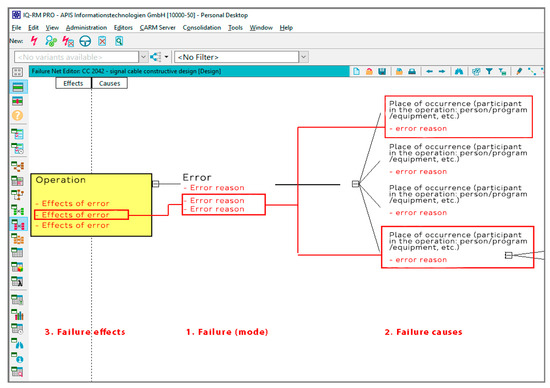
Figure 3.
Building blocks for risk analysis FMEA (the red lines in the figure indicate the chain of links between the blocks). Source: compiled by the authors.
After building the blocks, we need to upload a report (Figure 4), where we manually put down the grades (Figure 5) in accordance with the state standard 51901.12 2007 (IEC 60812:2006), see https://webstore.iec.ch/preview/info_iec60812%7Bed2.0%7Den_d.pdf, (accessed on 9 September 2023); this does not include the frequency indicator. Since the “occurrence” indicator is set on the basis of risk-repetition statistics in the enterprise, and each enterprise has its own frequency indicators, in this analysis, it focuses on the frequency of the cause of the risk, and not on the risk itself. The frequency of the risk cause was determined by an expert method through a survey of enterprise specialists, as well as views of specialized forums. The main indicator of the final assessment was the RPN coefficient, which is calculated by the following formula:
where:
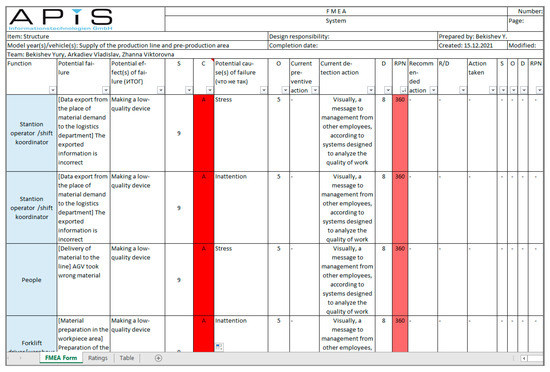
Figure 4.
Risk report in the process of supplying the production line and preproduction area. Source: compiled by the authors using the IQ-RM software from APIS.
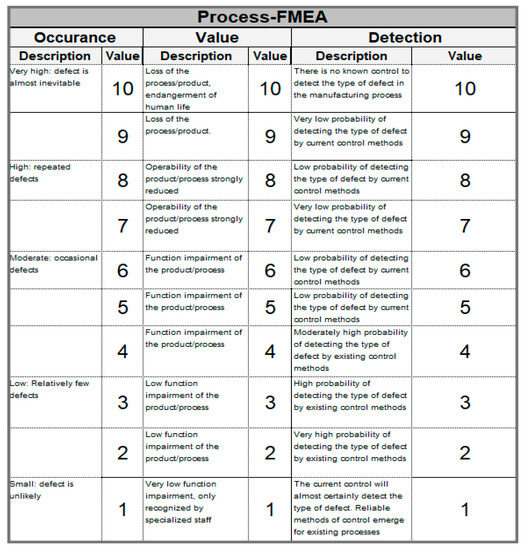
Figure 5.
FMEA risk assessment scale. Source: GOST R 51901.12 2007 (IEC 60812:2006)/IEC 60812:2006.
- SEV—severity, the significance of the consequences of the risk;
- OCC—occurrence, risk frequency;
- DET—detection, the ability to detect risk.
A total of 834 risks were identified by APIS in relation to the process of supplying the production line and the preproduction area. The following are the main results obtained during the analysis:
- Using Excel’s filtering and conditional formatting method, the red zone primarily consists of risks related to producing low-quality final devices (101 out of 834). This is due to high severity scores given by company experts and the frequent involvement of enterprise personnel. The analysis highlights challenges in real-time detection of employee stress and inattention, which can lead to errors with consequences such as production stoppage, disrupted supply plans, or the production of low-quality devices.
- The yellow zone primarily encompasses risks related to potential production stoppages during work hours (153 out of 834 risks). Most stem from Wi-Fi network failures and issues with internal communication devices in automated production infrastructure interacting with AGV/AMR technology, such as elevators, doors, and ramps. This can be attributed to fluctuating network coverage affected by external factors, including nearby communication devices and jammers. Additionally, a significant portion of risks involves breakdowns in devices interacting with AGVs/AMRs due to improper maintenance, wear, and incorrect equipment use by factory staff.
- The green zone includes risks mostly related to collision between AGV/AMR devices and plant personnel/equipment/devices. Despite the fact that the “severity” indicator for these risks is set to the maximum (10 points), due to the minimum indicators of “occurrence” and “detection”, these risks fell into the lowest limit of the table. Such low values in the variables are due to the fact that the possibility of occurrence (frequency) of such events is very unlikely due to the safety systems being integrated into AGVs/AMRs, their low speed of movement, and the high possibility of detecting a risk.
4. Discussion
For results evaluation, a general summary table was created (Figure 6).
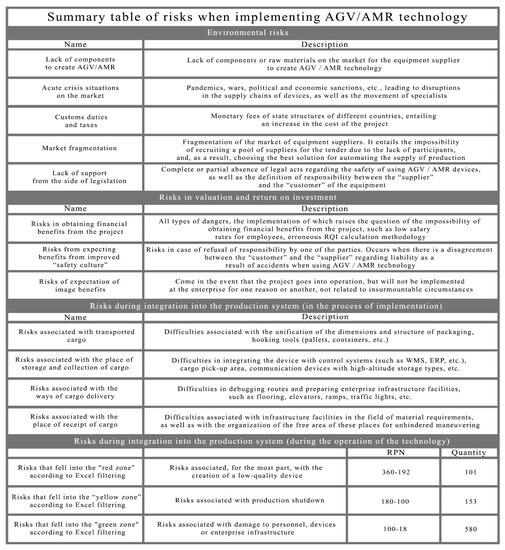
Figure 6.
Risks summary table.
During the risk analysis, we took into consideration the 580 risks associated with human injury out of 834 total identified threats. These have significant effects and can result in substantial consequences compared to the other types of risks examined. We ensured that these human injury risks fell within the acceptable “green zone”. Although it initially appears like a paradox when juxtaposed with real-world outcomes, our comprehensive analysis integrates these risks to prioritize safety and mitigate potential hazards. Personnel injury or fatality risks have decreased significantly due to various reasons, including the following:
- The occurrences of minor cuts and bruises are not considered to be significant risks as they are covered by the basic medical insurance provided in the social packages. Bosch Russia, for instance, recorded only four nonfatal incidents in more than a decade despite their large workforce of over 700 employees. This scenario is applicable to most companies, which have strict occupational health and safety regulations and comply with labor regulation. This is also confirmed by the conducted FMEA, which has shown that the frequency of realized risks is significantly lower than others.
- Most companies prioritize employee safety and health, as reflected by high FMEA severity scores. However, payouts for employee deaths are much lower than those for defects or production stoppage, which can harm a company’s reputation. Our analysis rates the severity of these risks as very high, indicating their importance in FMEA results. While the value of human life may vary, our findings reflect the current reality in transitive economies.
- Our research is focused on implementing high-tech and safe equipment where human risks are virtually eliminated.
This paper highlights the complexity and interconnectivity of risks in automation projects. To mitigate these risks, follow these recommendations:
- Choose project team members carefully, assigning them based on each stage’s tasks.
- Evaluate suppliers by analyzing the market and utilizing available resources.
- Examine relevant legislation to ensure smooth collaboration.
- Ask probing questions to understand suppliers’ viewpoints.
- Establish project deadlines and responsibilities to minimize disputes.
- Account for external risks from the beginning, and maintain communication with both parties’ management.
Regarding risk when evaluating a return on investment, the project team needs to prepare a list of all possible operations that could be replaced by AGV/AMR technology. This must be conducted for three reasons:
- To understand where, at the moment, it is possible to apply the technology. The option may differ from the one that was originally set by the management and offer a new option to the company’s management;
- Often, a project for the introduction of automated tools is long-term; most often it does not bring benefits when introducing 1–2 pieces of equipment, but works when you replace them with entire layers of operations performed at the factory;
- Top management who invests in the project at the time of its presentation may ask a completely fair question: “how do you see the future development of the project?”, as they will want to see the development of their capital over time, as well as understand the final cost of the entire project, which will help them in future planning.
In addition, the team is also required, when discussing with suppliers in a contractual manner (having documented this at the time of conclusion of the contract), to allocate responsibility for causing damage to employees/infrastructure/equipment by AGV/AMR equipment in a given situation, and also to determine the timing of repairing the device during breakdowns (they must be satisfactory for the customer, since the technology will continue to support entire operations, without which production can stop).
Moreover, the team must discuss contractually with suppliers the allocation of responsibility for potential damages to staff, infrastructure, or equipment by AGV/AMR devices, and establish suitable repair timelines during breakdowns to prevent production disruptions.
Regarding direct integration of AGV/AMR technology into production cycles, the team should fully understand the devices’ action algorithms, utilizing flowcharts or other process-modeling tools. Before submitting the project to the investment committee, all stakeholders involved in technology integration, including logistics, production, engineering, and maintenance departments, should be included in the team. The flowchart and risk analysis should be discussed with participants, management, and equipment suppliers individually to avoid issues and errors during implementation and to save time for consequence rectification.
Based on all the information collected, we present an algorithm developed in the framework of the study for dealing with the risks of such projects (Appendix I). There are 19 steps in the algorithm:
- Team selection: It is essential to carefully select a team best suited for the task at hand, considering both the members’ competencies and interpersonal compatibility. Establishing clear roles, responsibilities, and communication channels for the project manager, team members, and stakeholders (internal or external) is crucial for proper interaction and the prompt resolution of issues. Conducting an internal SWOT analysis to accurately gauge the department’s capabilities and resources prior to project initiation will help mitigate the risk of failure and associated negative consequences.
- SWOT analysis: Conducting an external SWOT analysis involves sending the project concept and goals to the procurement department. This offers two benefits: first, it streamlines understanding project needs, while procurement handles market analysis, saving time. Second, it prevents resource-wasting, unique solutions by leveraging standard options. Once requirements are shared, the procurement team evaluates the market for components, specialists, and solution viability, while the project team conducts a parallel analysis, ensuring cost-effective and optimal solutions for the project.
- Reviewing supplier lists and incoming proposals: Once the procurement department posts a cooperation request or sends proposals to organizations working on similar projects, responses will start coming in. However, before the initial meeting between the supplier and the project team, the supplier must be vetted for reliability and adherence to the organization’s external procurement criteria and policies.
- Revision and streamlining of the quote validation process: After a supplier has been approved and initial meetings have occurred, they submit a preliminary quote. At this stage, involve all relevant experts associated with the project’s objectives and those with expertise in various fields (e.g., engineering, design, logistics, finance). Conduct a workshop to evaluate each aspect of the quote and forward any questions from the experts to the supplier to refine the initial offer.
- Accumulation of proposals/preparation for the investment committee: After receiving a number of proposals agreed on with experts, it is necessary to prepare a summary of the proposed solutions and make the decision on which further orientation will be made. It is important that several vendors offer such a solution. Further, based on all available information on the project, it is necessary to prepare a one pager, which will summarize all the information for defending the project at the investment committee.
- One-page project analysis by third parties: After preparing a one-page project summary, it is essential to consult third parties for feedback, which can help avoid simple errors due to inattention. Despite approval from top management or organizational boards and guaranteed funding, thorough preparation is crucial. Management opinions may change, and projects often require multiple approvals, including potential opposition to certain aspects. Keep this in mind throughout the process.
- Checking of the project by the investment committee: After the project is submitted and defended in the investment committee and before a decision is made to allocate funds for it, the project is checked by special experts of the organization according to the rules and procedures that are enshrined in it (the organization).
- Fine-tuning of project details with specialists: Once funding is secured, proposals from each supplier must be thoroughly examined. Every decision should be meticulously addressed, and the final commercial offer should not have ambiguities or vague statements. This is crucial because making changes post-tender or prepayment becomes extremely challenging.
- Conducting of a parallel FMEA of financial risks alongside the debugging process: This enables error reduction and provides refined commercial offerings. This paper demonstrates utilizing FMEA in an automated enterprise technology project.
- Document and report preparation for the tender: Once final commercial proposals are received, suppliers must be notified in advance about required documentation. Timely notification is crucial due to preparation time involved. The organization then prepares terms of reference for the tender. If the project’s total cost increases after finalizing preliminary proposals, a new approval request is submitted to the investment committee. Either the updated amount is approved, or the project is adjusted to fit within the original scope.
- Conducting of the tender: During this stage, only personnel handling technical aspects of the tender can intervene in the process. Notably, companies not involved in approvals can also participate. These firms undergo integrity and risk checks and can become suppliers if successful. Rigorous evaluation of applications by procurement, as well as re-examination of previous partners, is crucial at this stage.
- Assessment of payment integrity: During advance payment and financial risk analysis, the financial and accounting departments should ensure the payment’s integrity and protect the organization from fraudulent schemes. The division of pre- and postpayment is necessary for safeguarding both the project’s customer and contractor.
- Risk management: Throughout the project, the team must work with the FMEA risk table, monitor progress, hold workshops on risk management, and oversee the integration of the infrastructure into the organization. It is crucial to communicate project information to all relevant employees to ensure proper understanding in case of future issues.
- Quality assurance: Afterward, the team must analyze and stress-test the developed solution to ensure its regular function and stability.
- Manager handover: Once tests are complete, the project is handed over to the manager, who decides if further questions or issues remain regarding the project and evaluates whether the supplier fully fulfilled the contract’s requirements.
- Financial assessment: When the project is handed over, the finance and accounting departments must address potential threats during the subsequent balance-of-funds transfer to the supplier.
- Investment committee review: The investment committee reviews the project team’s report, signed by the project’s supervising head, to analyze the validity of the money spent.
- Oversight: After project implementation, designate responsible employees for its ongoing use and oversight. Ideally, those informed about the project since its inception should be appointed.
- Generalization: Concurrently with the assignment of responsible employees, transfer the remaining and controlled FMEA risks to the enterprise’s general hazard control system for future monitoring and management.
This algorithm should help project teams in the enterprise in their work with failures, which will significantly reduce all kinds of financial losses.
Overall, FMEA is a systematic method used to identify and evaluate potential failure modes in a process, system, or product. By applying FMEA to projects implementing robotic technologies, several true benefits can be achieved:
- Risk Reduction: FMEA identifies various failure modes and their effects on the system, enabling project managers to prioritize risks and focus on the most severe and likely occurrences. This can lead to better mitigation strategies, decreasing the probability of failure and improving overall reliability.
- Cost Savings: Addressing potential failure modes and their effects early in the project can help prevent costly errors and rework later on. This can lead to significant cost savings in development, production, and maintenance stages.
- Improved Efficiency: FMEA can optimize the deployment of robotic technologies by identifying bottlenecks and inefficiencies in the system. This understanding can lead to performance enhancements, ultimately improving system efficiency and productivity.
- Enhanced Safety: Robotic technologies can pose safety risks to workers, especially when implemented in industrial settings. FMEA allows project teams to pinpoint potential hazards and develop safeguards to prevent accidents, leading to a safer work environment.
- Quality Improvement: By identifying and addressing failure modes, FMEA helps improve the quality and consistency of projects. This, in turn, leads to higher customer satisfaction and potential increases in market share.
- Streamlined Communication: FMEA requires extensive collaboration between various teams, such as engineering, software development, and operations. This cross-functional communication fosters a unified understanding of the project’s risks and fosters a problem-solving culture.
- Regulatory Compliance: Many industries subject to safety and quality regulations require the use of risk-management tools like FMEA. Employing FMEA can help demonstrate due diligence and ensure compliance with applicable standards and regulations.
Overall, integrating FMEA into projects implementing robotic technologies can lead to significant enhancements in risk reduction, cost savings, efficiency, safety, and quality while fostering a culture of collaboration and problem-solving.
5. Conclusions
In our research, we examined the risks associated with integrating mobile robots, specifically AGV/AMR equipment, into an enterprise’s internal supply system. We identified both external and internal risks, and used FMEA, based on a standard internal supply process flowchart, for a more precise risk assessment:
- The red zone: risks primarily associated with the creation of a low-quality final production device.
- The yellow zone: any possible production shutdowns during the working day (mostly due to Wi-Fi and internal communication devices of automatic production infrastructure facilities failure).
- The green zone: risks of a collision between AGV/AMR devices and plant personnel/equipment/devices.
Financial risk groups for projects implementing robotic technologies, such as “external environment group risks”, “investment efficiency assessment group risks”, and “production system integration group risks”, were identified and analyzed.
A methodology for working with FMEA risks was applied for the first time to analyze threats when implementing AGV/AMR automated technology in the enterprise’s internal supply system.
The developed methodology for managing risks in projects introducing automated technologies can be applied to various enterprises, regardless of their economic sector. This tool is flexible due to the ease of substitution and modification of the main system variables, as well as the universality of the approach, whose settings can be adapted precisely to the project’s needs without losing the quality of the analysis. Testing of the developed methodology showed that due to its flexibility and universality, it makes sense to apply the methodology and recommendations to all enterprises in different economic sectors where projects involving automated technologies are implemented. The use of this methodology allowed us, firstly, to prove the possibility of practical use of the methodology in cases of implementing automatic technology, thanks to the obtained objective and relevant results; secondly, based on the information received, to provide necessary recommendations for working with risks of similar projects; thirdly, to develop a scheme for working with financial risks of automation projects at the enterprise, which can be applied within the framework of any project involving high-tech technologies.
Practical recommendations are given for specialized company professionals to reduce financial consequences and additional burdens related to the implementation of financial risks arising from the implementation of the automated AGV/AMR system.
The data obtained during the work contribute to the scientific literature, complementing research in the field of financial risk management of organizations, allowing the formation of a structure for planning and controlling the AGV/AMR project (built during the risk analysis system construction), helping managers to make decisions, thereby contributing to achieving optimal productivity. In addition, this work provides a detailed theoretical basis for financial risks and systems for their control, starting with lexical analysis of the word “risk” and ending with the analysis of complex risk regulatory systems such as SAP, 1C, FMEA, etc.
The theoretical significance of the study is substantiated by the possibility of applying the research results when developing courses such as “Risk Management”, “Analysis of Financial Risks in Project Activities”, and “Project Risk Management”.
In summary, to effectively manage automation projects involving AGV/AMR technology, it is crucial to:
- Assemble a diverse project team comprising stakeholders from various relevant departments.
- Implement responsibility clauses in contracts with deadlines for project suppliers and customers.
- Assess the operational impact of AGV/AMR technology on resources, energy consumption, and long-term costs.
- Determine responsibility for damages or malfunctions caused by AGV/AMR equipment in contracts with suppliers.
- Ensure that the design team understands all of the process algorithms involved, discussing risk analysis with all parties involved.
We hope this research assists professionals in circumventing key challenges in automation projects and helps scientists in related fields better comprehend information support needs and the real-world economic landscape. Additionally, examining the risks of implementing such technologies could expedite companies’ transition to a green economy by optimizing energy expenses and reducing emissions, ultimately contributing to a greener and safer world. Future research on the topic “FMEA Model-Based Risk Analysis for AGV/AMR Integration in Internal Supply Systems” could consider the following directions:
- Adaption of FMEA for Industry 4.0 Technologies: With Industry 4.0 rapidly evolving, it would be worthwhile to study how FMEA integrates with technologies such as the Internet of Things (IoT), machine learning, and artificial intelligence to improve risk analysis and mitigation in AGV/AMR systems.
- Cross-functional Collaboration: Investigate the impact of cross-functional collaboration among various departments (design, engineering, logistics) on the effectiveness and efficiency of FMEA during AGV/AMR implementation.
- Development of Agile FMEA: Assess the potential of incorporating agile methodologies into the FMEA process, allowing for quicker, iterative, and incremental risk assessment throughout the AGV/AMR integration.
- FMEA Model Performance Metrics: Develop a set of performance metrics for evaluating the effectiveness of different FMEA implementations in AGV/AMR projects, which can help stakeholders select and refine the best risk-management practices.
- FMEA for Multiagent Systems: Investigate FMEA’s applicability for multiagent systems (MAS), where multiple AGVs or AMRs work simultaneously, to better assess the risks associated with complex interaction and communication patterns.
- Standardization of FMEA for AGV/AMR Integration: Develop guidelines and standard processes for using FMEA in the context of AGV/AMR system integration, facilitating easier comparison and adoption of best practices.
- FMEA Training and Education: Examine the role of targeted training and education programs in improving the application of FMEA for AGV/AMR system integration projects.
- Integration of FMEA with Other Risk Assessment Tools: Investigate the potential benefits of combining FMEA with other risk-analysis tools, such as Bayesian networks, fault tree analysis (FTA), or risk matrices, to deliver a more comprehensive risk assessment of AGV/AMR projects.
- FMEA for AGV/AMR Cybersecurity: Assess and develop an FMEA framework focused specifically on cybersecurity threats within AGV/AMR and internal supply systems, aiming to ensure the reliable and secure operation of smart factory environments.
These future research directions can contribute to a deeper understanding of FMEA model-based risk analysis for AGV/AMR integration in internal supply systems and facilitate the successful implementation of automation and robotics in various industries.
6. Limitations
In this study, the authors considered project risks in the context of the introduction of robotic technologies in enterprises.
Author Contributions
Methodology, Y.B. and Z.P.; Formal analysis, Z.P.; Resources, Y.B. and V.A.; Data curation, V.A.; Writing—original draft, Y.B. and Z.P. All authors have read and agreed to the published version of the manuscript.
Funding
This research received no external funding.
Data Availability Statement
Not applicable.
Acknowledgments
We would like to express our special gratitude to Viktoria Yasinskaya (BSH Household Appliances LLC), Konstantin Proskuryakov (Omron Electronics LLC), Vladimir Medvedev (JUNGHAINRICH Lifting and Loading Equipment LLC), and Roman Muksimov (Robovizard LLC) for completing the survey and providing invaluable assistance in writing the paper. We would also like to express special gratitude for filling out the questionnaire to the following companies: SAFELOG GmbH, InduTech LLC, Robotechnika LLC, and Energy LLC (NRG Co., Ltd.).
Conflicts of Interest
The authors declare no conflict of interest.
Appendix A
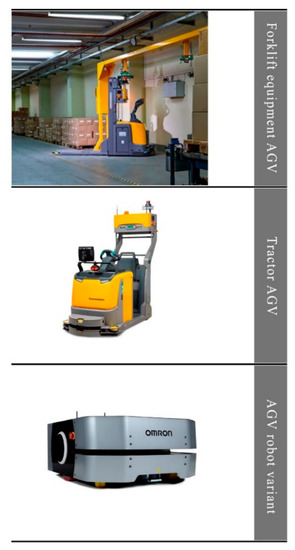
Figure A1.
Different types of AGV/AMR technology. Source: compiled by the authors of the work based on publicly available photos of devices.
Appendix B
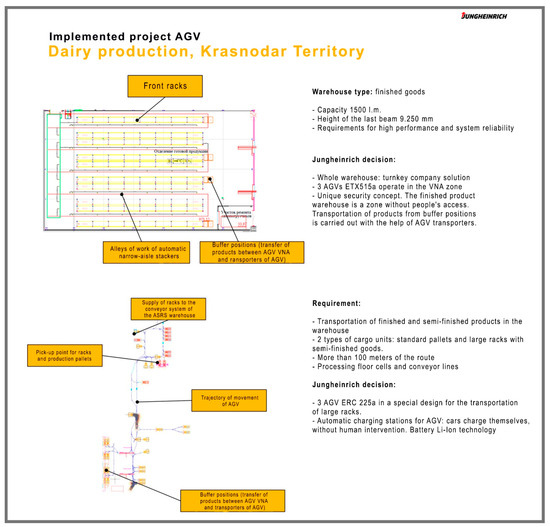
Figure A2.
An example of a completed project for the implementation of AGV in a dairy-products factory. Source: Prepared by the authors based on information provided by Jungheinrich (the name and all the exact details that could reveal the organization are hidden in order to maintain corporate secrecy).
Appendix C
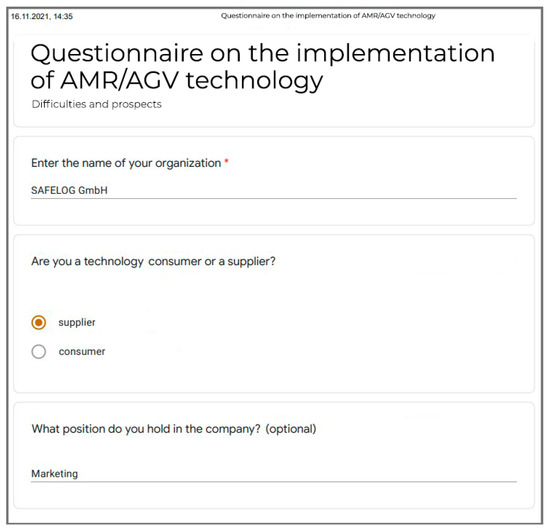
Figure A3.
Example of a completed survey, page 1. Source: compiled by the authors of the work.
Appendix D
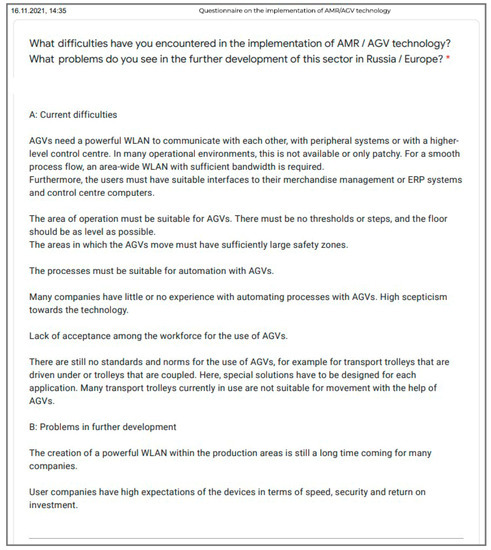
Figure A4.
Example of a completed survey, page 2. Source: compiled by the authors of the work.
Appendix E
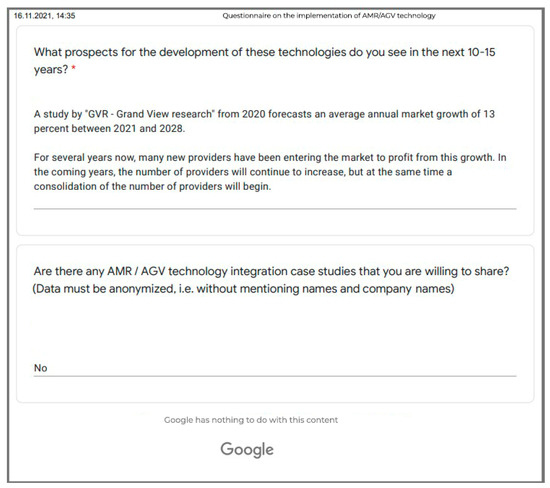
Figure A5.
Example of a completed survey, page 3. Source: compiled by the authors of the work.
Appendix F
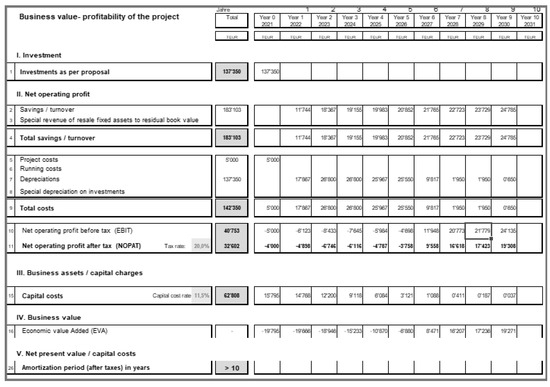
Figure A6.
An example of calculating the payback of the project. (All figures in this table are based on the total approximate value of assets on the companies’ public websites and the approximate average wage rate in Russia. The calculation is an example and is not a calculation in a real project.) Source: compiled by the authors of the work.
Appendix G
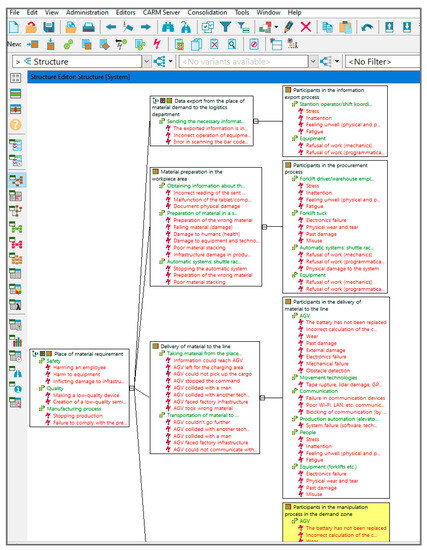
Figure A7.
FMEA Hazard Analysis Flowchart (Part 1). Source: compiled by the authors of the work.
Appendix H
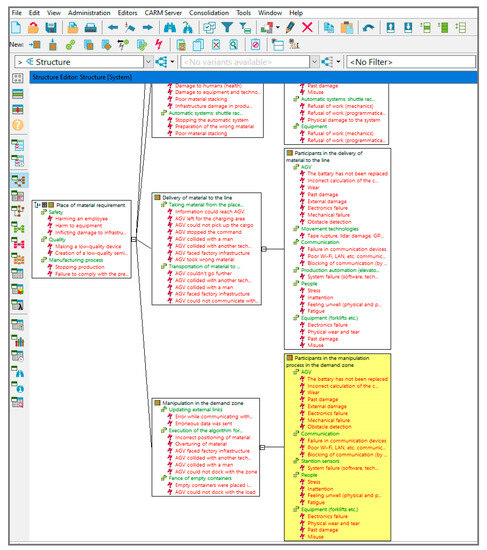
Figure A8.
FMEA Hazard Analysis Flowchart (Part 2). Source: compiled by the authors.
Appendix I
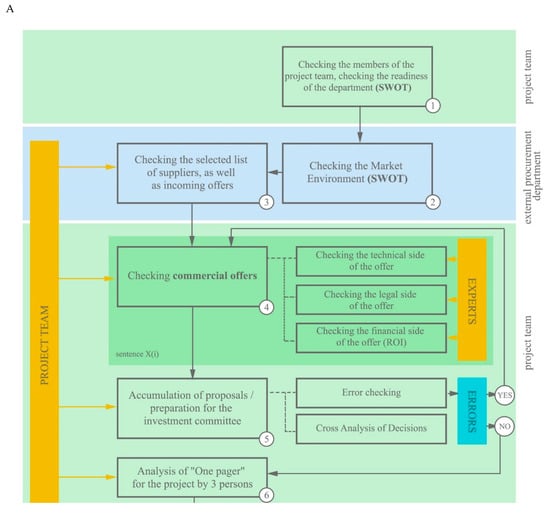
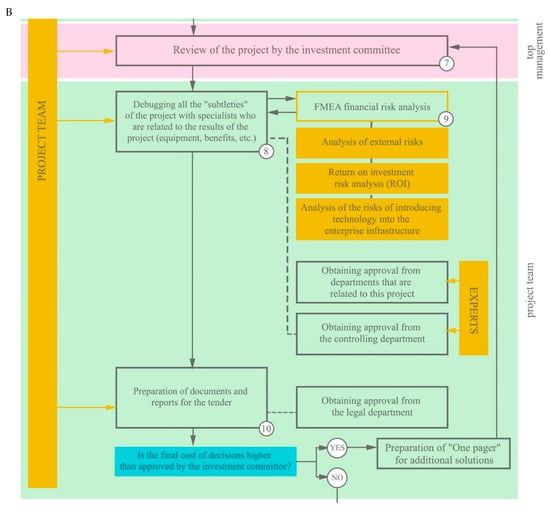
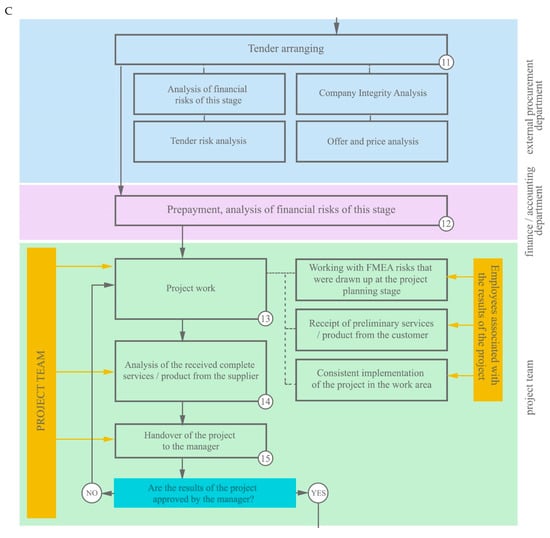
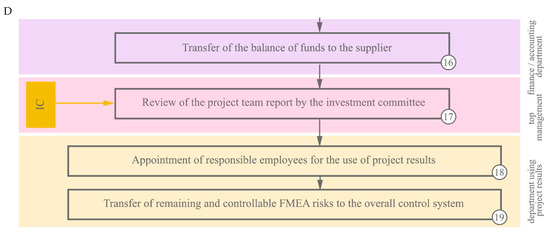
Figure A9.
Risk management scheme for high-tech projects (A–D). Source: compiled by the authors.
References
- Abdurrahman, Yılmaz, and Temeltas Hakan. 2019. Self-adaptive Monte Carlo method for indoor localization of smart AGVs using LIDAR data. Robotics and Autonomous Systems 122: 103285. [Google Scholar]
- Bogue, Robert. 2022. The changing face of the automotive robotics industry. Industrial Robot 49: 386–90. [Google Scholar]
- Bohacs, Gabor, Zs Győrváry, and Daniel Gaspar. 2021. Integrating scheduling and energy efficiency aspects in production logistic using AGV systems. IFAC-PapersOnLine 54: 294–99. [Google Scholar] [CrossRef]
- Decree of the Government of the Russian Federation on the Approval of the Document «Concept for the Development of Regulation of Relations in the Field of Artificial Intelligence Technologies and Robotics Until 2024». First Edition. 2020. Available online: https://www.economy.gov.ru/material/file/57ff642339b16c479b12030fb5f1b6e3/19082020_2129-p.pdf (accessed on 22 December 2021).
- De Ryck, Matthias, Davy Pissoort, Tom Holvoet, and Eric Demeester. 2021. Decentral task allocation for industrial AGV-systems with resource constraints. Journal of Manufacturing Systems 59: 310–19. [Google Scholar] [CrossRef]
- De Ryck, Matthias, Davy Pissoort, Tom Holvoet, and Eric Demeester. 2022. Decentral task allocation for industrial AGV-systems with routing constraints. Journal of Manufacturing Systems 62: 135–44. [Google Scholar] [CrossRef]
- Francisco, Rubio, Llopis-Albert Carlos, and Valero Francisco. 2021. Multi-objective optimization of costs and energy efficiency associated with autonomous industrial processes for sustainable growth. Technological Forecasting and Social Change 173: 121115. [Google Scholar]
- Guilherme, T. Aguiar, Gilson Oliveira Aguiar, Hua Tan Kim, Kazantsev Nikolai, and Setti Dalmarino. 2019. Sustainable Implementation Success Factors of AGVs in the Brazilian Industry Supply Chain Management. Procedia Manufacturing 39: 1577–86. [Google Scholar]
- Hana, Neradilova, and Fedorko Gabriel. 2017. Simulation of the Supply of Workplaces by the AGV in the Digital Factory. Procedia Engineering 192: 638–43. [Google Scholar]
- Hee-Woon, Cheong, and Lee Hwally. 2018. Requirements of AGV (Automated Guided Vehicle) for SMEs (Small and Medium-sized Enterprises). Procedia Computer Science 139: 91–94. [Google Scholar]
- Jittima, Varagul, and Ito Toshio. 2016. Simulation of Detecting Function object for AGV Using Computer Vision with Neural Network. Procedia Computer Science 96: 159–68. [Google Scholar]
- Johannes, Schmidt, Meyer-Barlag Claas, Eisel Matthias, M. Lutz, and Appelrath Hans-Jürgen. 2015. Using battery-electric AGVs in container terminals—Assessing the potential and optimizing the economic viability. Research in Transportation Business & Management 17: 99–111. [Google Scholar]
- Latino, Robert J., and Kenneth. C. Latino. 2006. Root Cause Analysis: Improving Performance for Bottom-Line Results. Boca Raton: CRC Press. [Google Scholar]
- Ludger, Overmeyer, Podszus Florian, and Dohrmann Lars. 2016. Multimodal speech and gesture control of AGVs, including EEG-based measurements of cognitive workload. CIRP Annals 65: 425–28. [Google Scholar]
- Martijn, Cramer, Cramer Jeroen, De Schepper David, Aerts Peter, Kellens Karel, and Demeester Eric. 2019. Benchmarking low-cost inertial measurement units for indoor localization and navigation of AGVs. Procedia CIRP 86: 204–9. [Google Scholar]
- Naslund, Dag, and Steven Williamson. 2010. Applying FMEA to Supply Chain Management. International Journal of Logistics Economics and Globalisation 2: 228–44. [Google Scholar]
- Ning, Ma, Zhou Chenhao, and Stephen Aloisius. 2021. Simulation model and performance evaluation of battery-powered AGV systems in automated container terminals. Simulation Modelling Practice and Theory 106: 102146. [Google Scholar]
- Nitish, Singh, Dang Quang, Akcay Alp, Adan Ivo, and Martagan Tugce. 2022. A metaheuristic for AGV scheduling with battery constraints. European Journal of Operational Research 298: 855–73. [Google Scholar]
- Ozan, Yesilyurt, Bauer Dennis, Emde Alexander, and Sauer Alexander. 2021. Why should the automated guided vehicles’ batteries be used in the manufacturing plants as an energy storage? E3S Web of Conferences 231: 01004. [Google Scholar]
- Pisarenko, Zhanna Viktorovna. 2014. Institutional Foundations for the Development of Pension Systems. St. Petersburg: Publishing House of St. Petersburg State University. 202p. [Google Scholar]
- Puneeth, Valmiki, Simha Abhinav, Gowtham P. Reddy, Panchakarla Gowtham, Kumar Kranthi, Purohit Rajesh, and Suhane Amit. 2018. A Study on Simulation Methods for AGV Fleet Size Estimation in a Flexible Manufacturing System. Materials Today: Proceedings 5: 3994–99. [Google Scholar]
- Quang-Vinh, Dang, Singh Nitish, Adan Ivo, Martagan Tugce, and Dirk van de Sande. 2021. Scheduling heterogeneous multi-load AGVs with battery constraints. Computers & Operations Research 136: 105517. [Google Scholar]
- Saadettin, Erhan Kesen, and Faruk Ömer. 2007. Simulation of automated guided vehicle (AGV) systems based on just-in-time (JIT) philosophy in a job-shop environment. Simulation Modelling Practice and Theory 15: 272–84. [Google Scholar]
- Stamatis, Dean H. 2003. Failure Mode and Effect Analysis: FMEA from Theory to Execution. Milwaukee: ASQ Quality Press. [Google Scholar]
- Stoychich, Mirko, Zeljko Stevic, Andrey Nikolic, and Zdravko Bozhichovich. 2019. Multi-criteria model for evaluation and selection of automatically guided vehicles (AGV) for warehouses. Modern Problems of the Risk Complex of Russia 9: 4–20. [Google Scholar]
- The European Bank for Reconstruction and Development (EBRD). 2022. What Is the EBRD’s Green Economy Transition Approach? Available online: https://www.ebrd.com/what-we-do/get.html (accessed on 15 December 2022).
- Vitalii, Naumov, Kubek Daniel, Więcek Paweł, Skalna Iwona, Duda Jerzy, Goncerz Robert, and Derlecki Tomasz. 2021. Optimizing Energy Consumption in Internal Transportation Using Dynamic Transportation Vehicles Assignment Model: Case Study in Printing Company. Energies 14: 4557. [Google Scholar]
- Weiyang, Lin, Ren Xinyang, Hu Jianjun, He Yuzhe, Li Zhan, and Tong Mingsi. 2018. Fast, robust and accurate posture detection algorithm based on Kalman filter and SSD for AGV. Neurocomputing 316: 306–12. [Google Scholar]
- Wiferion. 2022. Energy Supply of AGVs & Co—A Lot of Potential for Optimization. Available online: https://www.wiferion.com/en/news/energy-supply-agvs-optimization (accessed on 10 March 2022).
- Xiangnan, Zhan, Xu Liyun, Zhang Jian, and Li Aiping. 2019. Study on AGVs battery charging strategy for improving utilization. Procedia CIRP 81: 558–63. [Google Scholar]
Disclaimer/Publisher’s Note: The statements, opinions and data contained in all publications are solely those of the individual author(s) and contributor(s) and not of MDPI and/or the editor(s). MDPI and/or the editor(s) disclaim responsibility for any injury to people or property resulting from any ideas, methods, instructions or products referred to in the content. |
© 2023 by the authors. Licensee MDPI, Basel, Switzerland. This article is an open access article distributed under the terms and conditions of the Creative Commons Attribution (CC BY) license (https://creativecommons.org/licenses/by/4.0/).